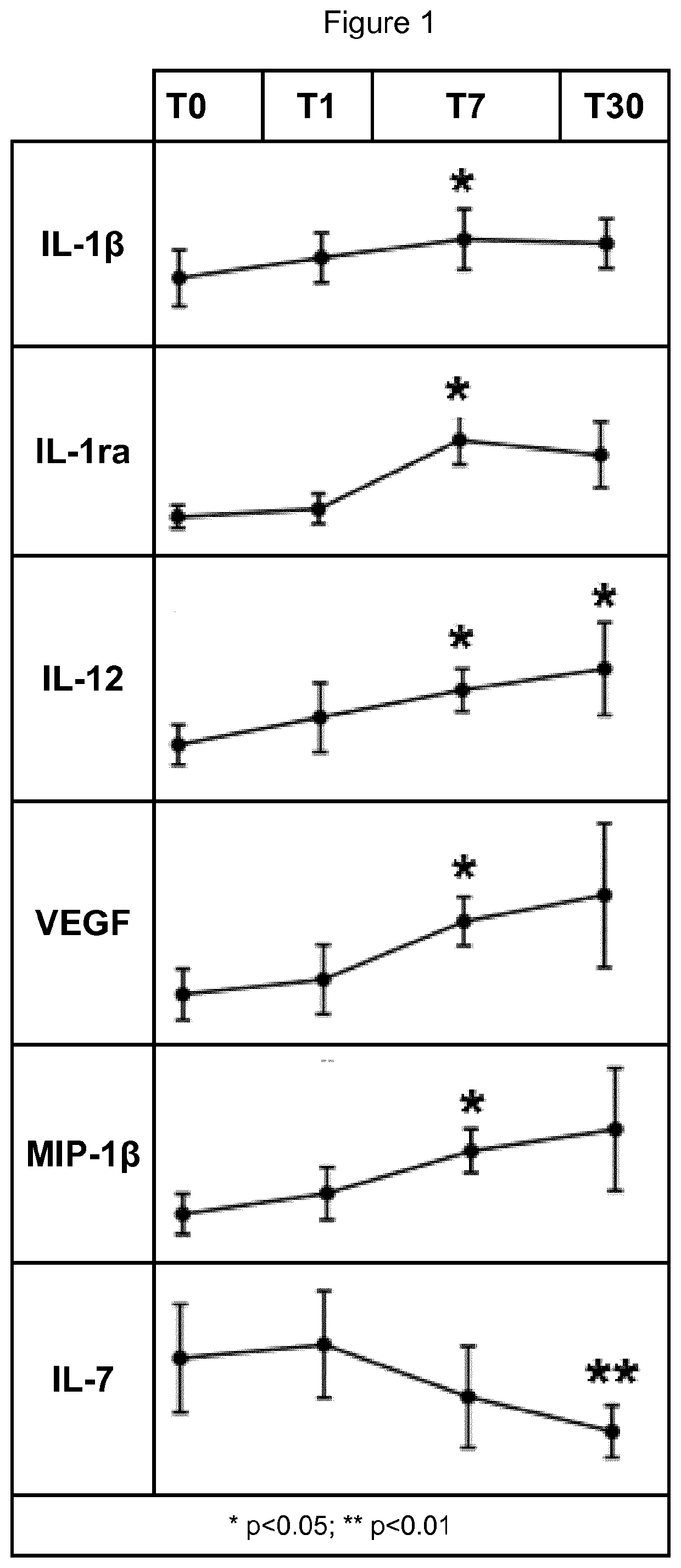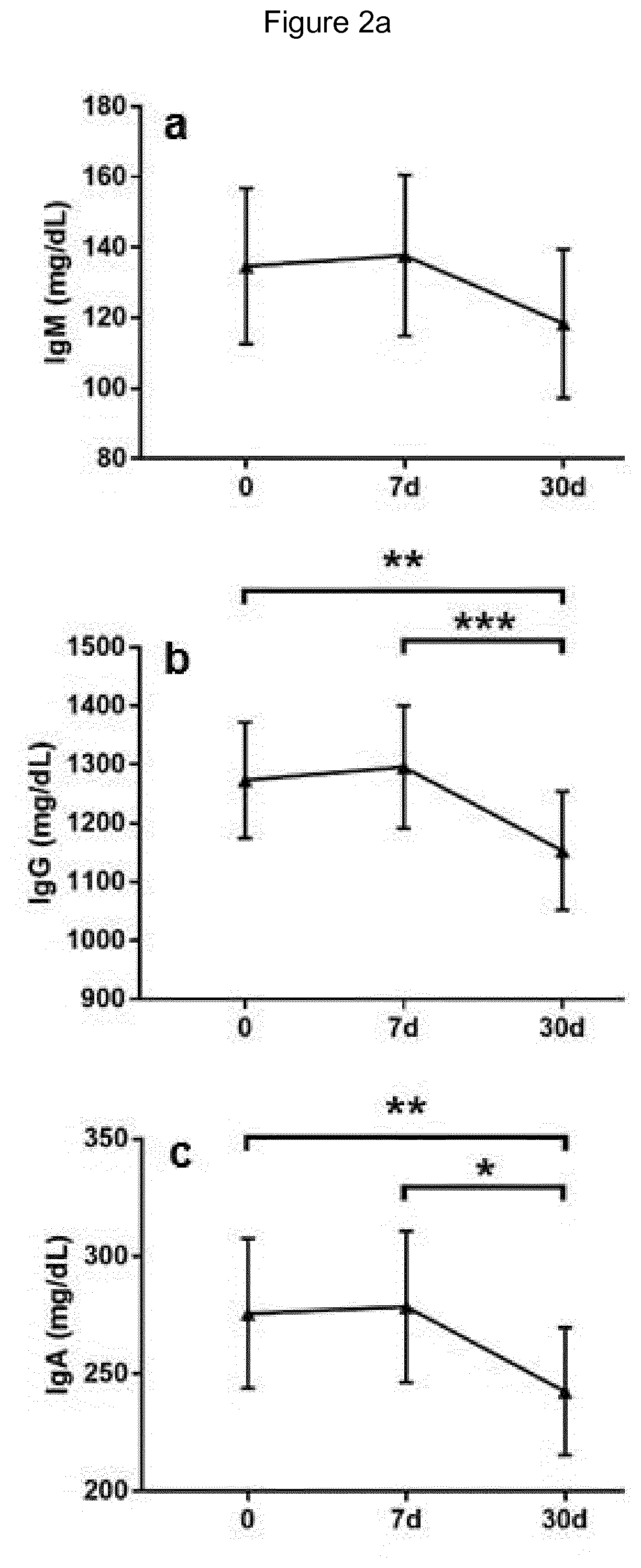Polidocanol for use as immunomodulating agent
- Summary
- Abstract
- Description
- Claims
- Application Information
AI Technical Summary
Benefits of technology
Problems solved by technology
Method used
Image
Examples
example 1
Functional Injective Treatment (FIT) with diluted polidocanol
[0047]A commercially available polidocanol solution (Atossisclerol®) was diluted to 0.05% with a physiological saline solution. A 1.4% sodium bicarbonate solution was then added in order to obtain a final concentration of 0.06%. The patients, 80% of which were female between 18 and 82 years of age suffering from venous insufficiency from minor to severe, were subjected to treatment after obtaining their free and informed consent.
[0048]Before the treatment, about 100 patients were subjected to a survey in order to assess their quality of life and to evaluate possible variations of the phlogistic / inflammatory overall state, of the venous microcirculation and circulation functionality, and also, more in general, of the skin trophism.
[0049]After evaluating the survey answers, better described in examples 2 and 3, it was decided to thoroughly investigate the patients inflammation serum parameters and, more in general, the immun...
example 2
Evaluation of the Long Term Systemic Effects of diluted polidocanol: QoL Survey
[0050]The long term systemic effects were evaluated via a survey given to patients after 3 or 4 treatments with diluted polidocanol.
[0051]In particular, they were asked to fill out a survey (CIVIQ-20) according to the criteria defined in Launois R. et al “Construction and validation of a quality of life questionnaire in chronic lower limb venous insufficiency (CIVIQ), Qual. Life Res., 1996, 5(6):539-554.
[0052]The survey contained the questions summarized hereinbelow, with answers indexed with values from 0 to 4 (0 if the feeling of discomfort described by the question was not applicable and from 1 to 4 if it was applicable with increasing intensity). Hereinbelow are collected the activities which turned out to be improved after the treatment:[0053]1) During the last 4 weeks have you felt pain in the hips or legs and with what intensity? In 14% of cases a decrease in hip pain was observed after treatment w...
example 3
Likert Survey on the “inflammatory” State in Treated Subjects
[0076]To the questions on the quality of life, 10 more specific questions were added in order to assess possible variations of the “inflammatory” state (n=100 patients) after the treatment. The survey was based on the indications of: “Evaluation by Likert-type scale 4-point (0-absent, 1-moderate, 2-severe and 3-very severe)” Elleuch et al. Adv Ther. 2016 September; 33(9):1536-49. Subjects were asked a self-assessment after each treatment andthe results of the survey were evaluated after 8-10 months (i.e. after at least 4-5 treatments).
[0077]The survey was tailored on the Likert scale and aimed at evaluating the reduction of a number of symptoms related to chronic phlogosis, such as arthrosic or arthritis manifestations (both generic and autoimmune) with particular reference to articular mobility and pain, in subjects not suffering from full-blown diseases and apparently normal.
[0078]The answers were indexed according to a ...
PUM
| Property | Measurement | Unit |
|---|---|---|
| Fraction | aaaaa | aaaaa |
| Fraction | aaaaa | aaaaa |
| Fraction | aaaaa | aaaaa |
Abstract
Description
Claims
Application Information
 Login to View More
Login to View More - R&D
- Intellectual Property
- Life Sciences
- Materials
- Tech Scout
- Unparalleled Data Quality
- Higher Quality Content
- 60% Fewer Hallucinations
Browse by: Latest US Patents, China's latest patents, Technical Efficacy Thesaurus, Application Domain, Technology Topic, Popular Technical Reports.
© 2025 PatSnap. All rights reserved.Legal|Privacy policy|Modern Slavery Act Transparency Statement|Sitemap|About US| Contact US: help@patsnap.com



